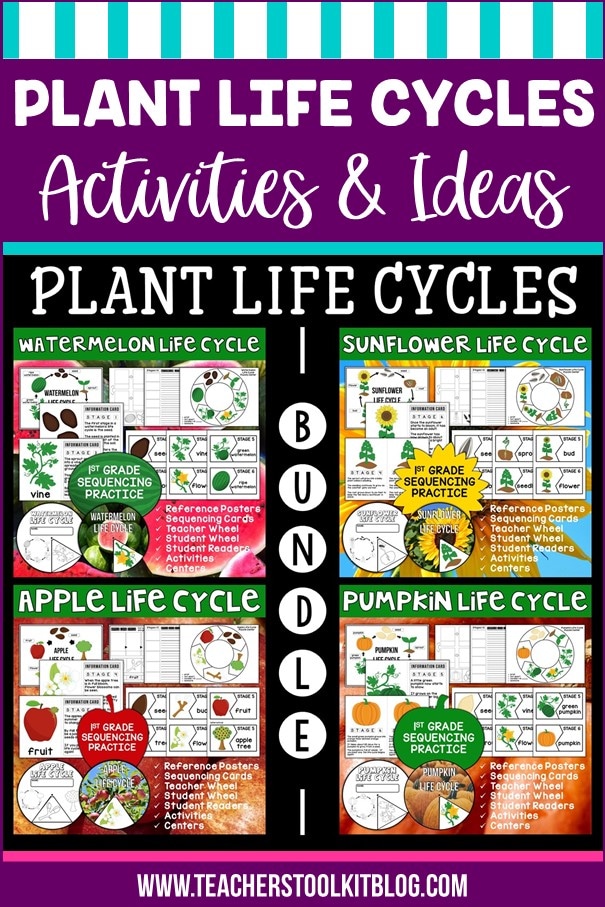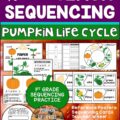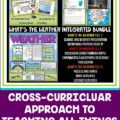When we begin to get that “spring-y” feeling… it’s time to teach about plant life cycles!
Soon we’ll be starting to see little green shoots pushing up through the soil … what better time to start teaching young students about plants? Read my other post about teaching plants in the fall.
plant life cycle activities
It’s hard to teach about plants without having some green, growing things in your classroom. Pull in some gardening lessons with your plant life cycles lessons, and grow veggies from scraps!
This is an experiment that your students will love! It’s pretty easy to get started.
Here’s a list of some veggies that are easy to grow from scraps:
- potatoes and sweet potatoes
- celery
- leafy greens like bok choy and lettuce
- cabbage
- onions and relatives like garlic and shallots
Potatoes are really easy to grow. All you’ll need is a few potatoes with “eyes,” a container, and some potting soil. Simply cut the potatoes into small pieces, making sure that each piece has an eye. Let them dry out a bit overnight and then plant them in some soil with the eye facing up.

You can regrow sweet potatoes in almost the same way. Cut a yam or sweet potato in half and suspend each half in a shallow container of water using toothpicks. Soon you’ll see roots start to grow. Shortly after that you’ll see green shoots growing from the top.
Another plant that would be easy to grow in your classroom is celery. Cut off the bottom of the bunch and place it in a shallow bowl of water. Make sure to keep it in a sunny place. It’s that simple! Soon you’ll start to see leaves grow from the bunch. You can let these grow and actually harvest them to eat or you can even replant the rooted celery in your garden!
Watching Seeds Grow
Watching how seeds grow is also a really fun experiment. Try this activity to let your students see what happens underground.
You’ll need: a large jar (a mason jar works great, or something like a mayonnaise jar), water, paper towels, and seeds. Radishes, peas, and beans grow quickly for fast results.
To get started, fold or crinkle up the paper towels and shove them down into the jar. Make sure not to pack them too tightly. Pour some water into the jar to wet the paper towels, but don’t flood the jar! Now push your seeds down into the outside of the jar so that they can be seen. The paper towels should hold them in place.
You can also add some fun variations to this experiment.
- Set up two jars and the same type of seeds in each. Place one jar in a sunny location and the other jar in the dark. See if both grow and which one grows first.
- Use different types of seeds in the jar and keep track of which seeds grow the fastest.
- Try setting up three jars with the same type of seeds in each. Measure the amount of water used and have one jar with no water, one half wet, and one fully wet.
Plant Life Cycles Unit Resource
If you’d like to incorporate literacy activities while doing these fun experiments, you might be interested in this Plant Life Cycles Bundle.
This Plant Life Cycles Bundle is designed for young elementary students and focuses on the stages of four different life cycles. Life cycles are an area of high interest for first graders, as they are naturally curious about the world around them. This bundle contains all you need to teach and review plant life cycles, in both challenging and fun ways.
Teacher notes and instructions are included throughout, and some activities include an element of flexibility.
Here’s what each separate life cycle contains:
- Teacher Notes
- Reference Poster
- Discussion/Sequencing Cards
- Teacher Review Life Cycle Wheel
- Student Review Life Cycle Wheel Craft
- Student Reader – color and ink-saving
- ACTIVITIES
- Life Cycle Cut and Glue
- Drawing and Writing sequentially
- CENTERS
- Ring Life Cycle Puzzle Center
- Life Cycle Match Up Cards – stage/name, picture
Each plant life cycle is also available as an individual mini-unit.
- Watermelon Life Cycle Mini Unit
- Sunflower Life Cycle Mini Unit
- Apple Life Cycle Mini Unit
- Pumpkin Life Cycle Mini Unit
Have you done some fun experiments with plants? Please share in the comments!



